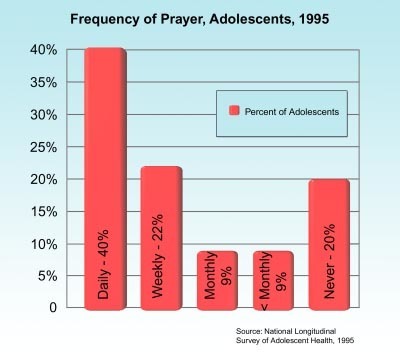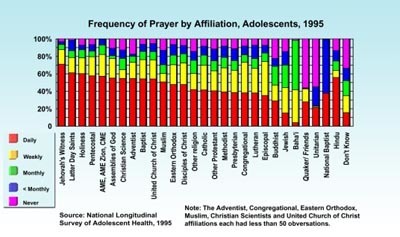Do Teens Pray? How Often?
Fully 80 percent of all American teenagers pray. Of these, 40 percent pray daily, and an additional 22 percent pray weekly, according to data from the 1995 National Longitudinal Survey of Adolescent Health. Nine percent each pray only monthly or less than monthly.

The 20 percent figure for never praying very likely underestimates the amount of actual teenage prayer, since 13 of the 20 percent who apparently "never" pray were respondents who had answered "none" to the prior religious affiliation screening question and so were simply not given the frequency of prayer question. They were automatically assigned to the "no prayer" answer category, even though they may pray.
Frequency of prayer also clearly varies by religious affiliation, as shown below. Teenagers in more theologically conservative, Pentecostal, and sectarian traditions pray more frequently. Jewish, mainline Protestant, Catholic, Baha'i, Buddhist and Quaker youth tend to pray somewhat less frequently.

This preliminary analysis is designed to provide baseline information that will aid in the development of a comprehensive survey of adolescents for the National Study of Youth and Religion, a four-year research project being conducted at the University of North Carolina, Chapel Hill under the direction of Dr. Christian Smith. Funded by Lilly Endowment, Inc., this project is designed to enhance our understanding of the religious and spiritual lives of American adolescents.
Analysis of data was completed by Christian Smith, Melinda Lundquist Denton and Mark Regnerus. Christian Smith is Professor and Associate Chair of Sociology at the University of North Carolina, Chapel Hill. Melinda Lundquist Denton is a Ph.D. graduate student in sociology at the University of North Carolina, Chapel Hill. Mark Regnerus is Assistant Professor of Sociology at the University of Texas at Austin.
The National Longitudinal Survey of Adolescent Health is a nationally representative school-based study of adolescents focusing on the social context of healthy behavior. Eighty eligible high schools-both public and private-were drawn from a national sampling frame of high schools. The recruitment rate of the originally sampled high schools was over 70 percent. The Add Health survey was administered in school, from the Fall of 1994 to the Spring of 1995, to all students grades 7 to 12 present on the survey date, and was completed by over 90,000 students. Note that by design, Add Health data do not include school drop-outs and home-schooled youth.
5-2-02
Fully 80 percent of all American teenagers pray. Of these, 40 percent pray daily, and an additional 22 percent pray weekly, according to data from the 1995 National Longitudinal Survey of Adolescent Health. Nine percent each pray only monthly or less than monthly. The 20 percent figure for never praying very likely underestimates the amount of actual teenage prayer, since 13 of the 20 percent who apparently "never" pray were respondents who had answered "none" to the prior religious affiliation screening question and so were simply not given the frequency of prayer question. They were automatically assigned to the "no prayer" answer category, even though they may pray. Frequency of prayer also clearly varies by religious affiliation, as shown below. Teenagers in more theologically conservative, Pentecostal, and sectarian traditions pray more frequently. Jewish, mainline Protestant, Catholic, Baha'i, Buddhist and Quaker youth tend to pray somewhat less frequently. This preliminary analysis is designed to provide baseline information that will aid in the development of a comprehensive survey of adolescents for the National Study of Youth and Religion, a four-year research project being conducted at the University of North Carolina, Chapel Hill under the direction of Dr. Christian Smith. Funded by Lilly Endowment, Inc., this project is designed to enhance our understanding of the religious and spiritual lives of American adolescents.
